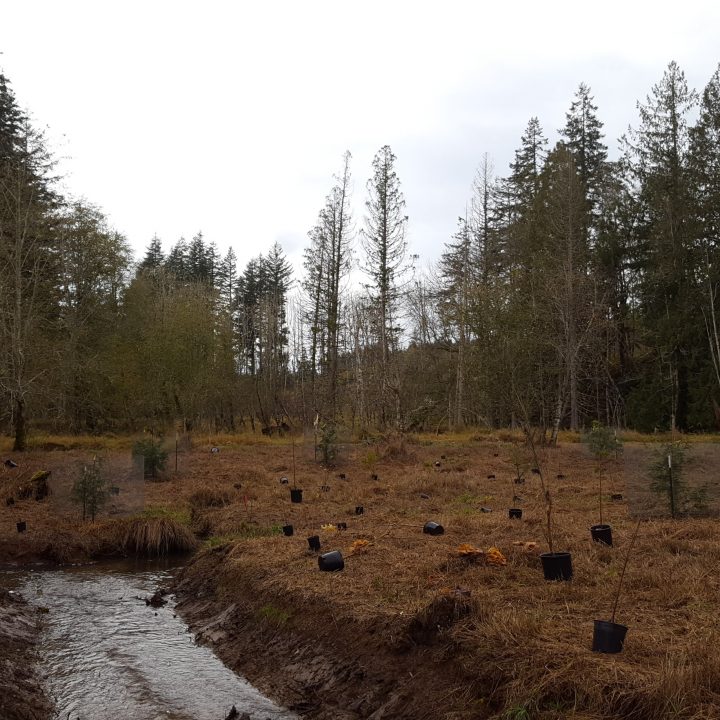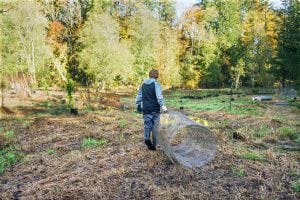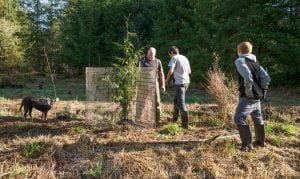www.ChehalisLeadEntity.org
News

Wisner Creek project restores channel, fights back Reed Canary Grass
Wisner Creek project restores channel, fights back Reed Canary Grass

What was once nearly 40 acres of unmanageable wetlands near Adna is being transformed into a thriving ecosystem by a group of energetic landowners and volunteers. In the process, the two struggling creeks that bisect the acreage are again free to flow on their merry way.
And that’s terrific news for the coho salmon that have been trying to navigate the waterways for untold years.
“My partners and I are convinced that the greater good for all of us is to revitalize the fish habitat on the land and combine that with a wetlands park.”

That’s Chehalis resident Bob Russell telling it like it is. Back in 2007, Russell and two other visionaries bought 88 acres of property off of Washington State Route 6 in the Chehalis River Basin near Adna — home to stretches of Mill and Wisner Creeks, which empty into the Chehalis River some 3 miles from the property.
Their goal was — and still is — to build approximately eight homes in a residential community called Beaver Glen, each on a 5-acre parcel in this secluded Chehalis setting. About half the houses are already built and ready to be occupied.
But in the process, Russell, 58, his co-owners, and the Beaver Glen Homeowners Association (HOA) had to figure out what to do with the 40-acre wetland in the middle of the property where no homes could be built and humans couldn’t tread for fear of being engulfed in tall reed canary grass.
So with help from a grant secured by the Lewis County Conservation District and consent from the HOA, an engineer was hired about a year ago to determine how the wetland’s creeks could be made more salmon friendly. Then in July a contractor began excavating the creek beds to uncover the rocky core and in early October another contractor began whacking the grass and weeds along the creeks’ banks.
The salmon, though, as Russell learned, had somehow navigated the creeks for as long as anyone could remember — even under the most adverse conditions that included beaver dams. They had succeeded, ultimately, only after heavy rains pulled them across a sea of impassable reed canary grass.
“After the first hard rain last winter, the salmon were everywhere, but the only way they could get across the grass was to ride through on heavy rain,” Russell said. “We’re hoping now that we’ve exposed the creek bed rock bottoms and cut the grass the salmon will be able to spawn this winter.”
To help ensure the site’s grass doesn’t grow back to choke the creeks, Russell, Lewis County Conservation District Special Projects Coordinator Kelly Verd, Beaver Glen homeowner Rick Naten and others spent a brilliant, late October day planting trees along the banks of the creeks.
“We want to reclaim this grassland into forest,” Russell explained, noting that logging on the land about 60 years ago allowed the grass to thrive. “We hope that in about three years when the trees are tall enough they will offer enough shade to permanently kill all that grass.”
According to Verd — who spent much of her morning schlepping 3- to 4-foot-tall trees from their resting spots at the edge of the wetland acreage to the banks of Wisner Creek — the crew that day and the following weekend planted 825 trees along the newly constructed creek channel. The mostly wet soil varieties included cottonwoods, cedars, spruce, swamp crab apple and vine maples — 20 species in all.

Russell and crew then placed wire-mesh cages about 5 feet tall around 25 of the cedars to prevent deer from eating them. And that’s where a couple of Lewis County teenagers enter the story.
The youth, aged 14 and 16, were obligated by the Lewis County Juvenile Detention Center to help this day, and they spent much of their time constructing the metal cages.
The teens, part of the detention center’s work crew, ended up at this particular work site through a partnership between the detention center and Washington Capital Region Education Service District 113.
ESD 113 provides administrative support for 44 school districts and approved private schools in Thurston, Mason, Lewis, Grays Harbor and Pacific counties. The ESD 113 program — called the Chehalis Basin Education Consortium — is funded by the “No Child Left Inside” grant with the Washington Recreation and Conservation Office.
Rachel Stendahl, ESD 113 regional service coordinator, hopes during the school year to involve more than 100 youth aged 13 to 21 in the conservation program. The participating youth are housed either in the detention center or are part of its work crew.
Stendahl said the youth will learn about watersheds and water quality, receive environmental education materials, attend lectures on environmental topics, grow plants in an onsite greenhouse, and participate in planting and restoration work offsite.
She was confident the work crew at the Beaver Glen site would “hopefully enhance their sense of place and understand the importance of riparian buffers to stream health.”

The detention center teens hoped they would learn something this day, too, though they admitted being sleep deprived. The older youth said he got out of bed that morning at 7:00 a.m., a far cry from his normal 2:00 p.m. Saturday rising time. But with a positive outlook and a brave face, he got down to a healthy day’s work.
“It’s good work because it’s helping the habitat for the wildlife of the area and also for the people who eat salmon,” he said, noting he had never planted trees before. “It makes me feel like I’m supporting the community by being out here.”
The younger boy, who said he would normally have slept until about 11:00 a.m. on a normal Saturday, wasn’t so sure about the “good work” part of Peterson’s description, though like his friend seemed determined to prove himself worthy.
“I’d rather be home than working,” he said. “But I know I’m helping the environment by doing this, and that makes me feel good.”
Later in the day as he basked under a brilliant fall sun, the teenager came to a sudden, positive conclusion. He had been examining a new cedar tree he’d just helped plant when he realized he’d been enjoying himself.
“This work isn’t as bad as I thought it would be,” he said.
Nearby, his workmate was momentarily coming to the opposite conclusion. As he struggled to dig a hole for another cedar tree, his left foot sunk ankle deep in the mushy soil.

“OK, I’m taking a nap right now on the ground and go to sleep,” he told his grinning pal.
Verd, meanwhile, who was still hauling trees back and forth to the creek banks, praised the teenagers’ work that morning.
“I know these kids are pretty good workers, and it’s good for them to learn about conservation and help with this project,” she said.
As the morning progressed and more and more trees occupied freshly dug holes, Naten — working nearby — looked around, smiled and sighed with satisfaction.
“It’s (creek enhancement) a great improvement to the environment and what this community stands for,” he said. “We care about improving our natural resources, taking care of Mother Earth and all that God has given us. It also gives me a nice place to take my dogs for a walk.”
And come winter, the salmon in Wisner and Mill creeks will have a nice place to swim before they finally rest their swishing tails.